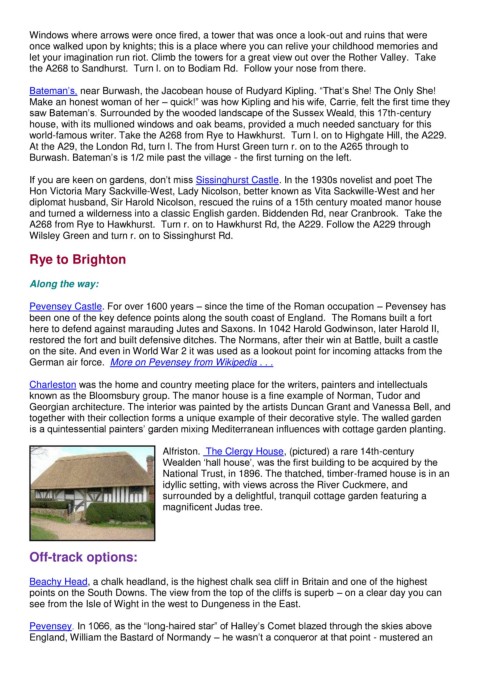Page 49 - demo
P. 49
Windows where arrows were once fired, a tower that was once a look-out and ruins that were
once walked upon by knights; this is a place where you can relive your childhood memories and
let your imagination run riot. Climb the towers for a great view out over the Rother Valley. Take
the A268 to Sandhurst. Turn l. on to Bodiam Rd. Follow your nose from there.
Bateman’s, near Burwash, the Jacobean house of Rudyard Kipling. “That’s She! The Only She!
Make an honest woman of her – quick!” was how Kipling and his wife, Carrie, felt the first time they
saw Bateman’s. Surrounded by the wooded landscape of the Sussex Weald, this 17th-century
house, with its mullioned windows and oak beams, provided a much needed sanctuary for this
world-famous writer. Take the A268 from Rye to Hawkhurst. Turn l. on to Highgate Hill, the A229.
At the A29, the London Rd, turn l. The from Hurst Green turn r. on to the A265 through to
Burwash. Bateman’s is 1/2 mile past the village - the first turning on the left.
If you are keen on gardens, don’t miss Sissinghurst Castle. In the 1930s novelist and poet The
Hon Victoria Mary Sackville-West, Lady Nicolson, better known as Vita Sackwille-West and her
diplomat husband, Sir Harold Nicolson, rescued the ruins of a 15th century moated manor house
and turned a wilderness into a classic English garden. Biddenden Rd, near Cranbrook. Take the
A268 from Rye to Hawkhurst. Turn r. on to Hawkhurst Rd, the A229. Follow the A229 through
Wilsley Green and turn r. on to Sissinghurst Rd.
Rye to Brighton
Along the way:
Pevensey Castle. For over 1600 years – since the time of the Roman occupation – Pevensey has
been one of the key defence points along the south coast of England. The Romans built a fort
here to defend against marauding Jutes and Saxons. In 1042 Harold Godwinson, later Harold II,
restored the fort and built defensive ditches. The Normans, after their win at Battle, built a castle
on the site. And even in World War 2 it was used as a lookout point for incoming attacks from the
German air force. More on Pevensey from Wikipedia . . .
Charleston was the home and country meeting place for the writers, painters and intellectuals
known as the Bloomsbury group. The manor house is a fine example of Norman, Tudor and
Georgian architecture. The interior was painted by the artists Duncan Grant and Vanessa Bell, and
together with their collection forms a unique example of their decorative style. The walled garden
is a quintessential painters’ garden mixing Mediterranean influences with cottage garden planting.
Alfriston. The Clergy House, (pictured) a rare 14th-century
Wealden ‘hall house’, was the first building to be acquired by the
National Trust, in 1896. The thatched, timber-framed house is in an
idyllic setting, with views across the River Cuckmere, and
surrounded by a delightful, tranquil cottage garden featuring a
magnificent Judas tree.
Off-track options:
Beachy Head, a chalk headland, is the highest chalk sea cliff in Britain and one of the highest
points on the South Downs. The view from the top of the cliffs is superb – on a clear day you can
see from the Isle of Wight in the west to Dungeness in the East.
Pevensey. In 1066, as the “long-haired star” of Halley’s Comet blazed through the skies above
England, William the Bastard of Normandy – he wasn’t a conqueror at that point - mustered an

